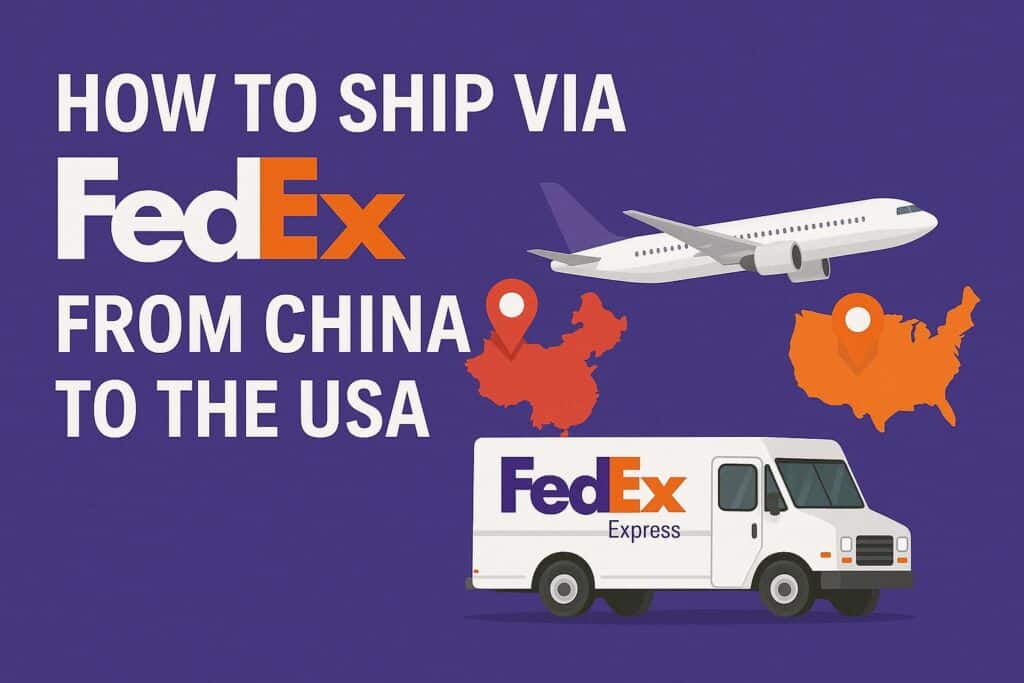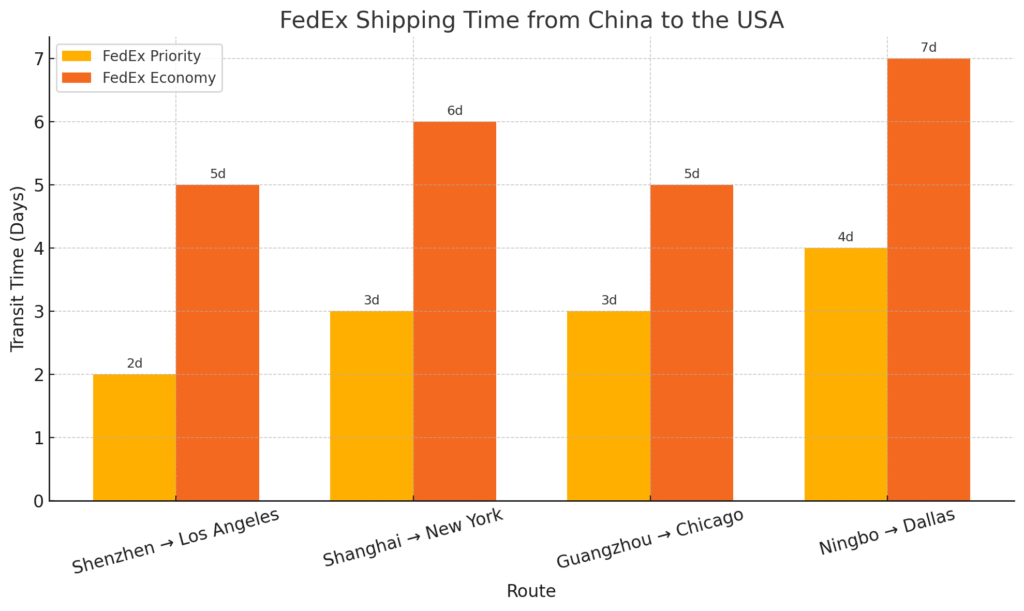How to ship via FedEx from China to the USA is a question many importers, e-commerce sellers, and logistics managers frequently ask when dealing with international trade. As one of the most trusted global carriers, FedEx offers fast, secure, and trackable deliveries that connect Chinese suppliers with American markets.
Whether you’re a business owner or an individual shipper, understanding how FedEx international shipping works will help you make informed decisions, avoid delays, and reduce hidden charges. In this complete guide, we’ll walk through the FedEx process—covering delivery timelines, shipping costs, customs clearance, required documentation, and expert tips.

Why Use FedEx for Global Shipping from China?
FedEx is known for its global coverage, speed, and professional handling of cross-border shipments. As one of the world’s leading logistics companies, FedEx has established a strong presence in China with multiple offices, warehouses, and FedEx locations in cities like Shanghai, Guangzhou, and Shenzhen. For businesses shipping internationally, this makes FedEx international service highly accessible and efficient.
Whether you’re shipping a small package or high-volume merchandise, FedEx offers reliable pickup and delivery services, complete tracking numbers, and options tailored to your budget and urgency. Its wide range of solutions—like FedEx International Priority and FedEx International Economy—makes it easier to reach your customers in the USA, even with tight deadlines.
Choosing FedEx also means simplified customs clearance support, which is crucial for smooth operations and avoiding delays at borders. FedEx works closely with customs brokers and provides tools to help you prepare the necessary customs documents and comply with U.S. regulations.
FedEx International Services from China to the USA
FedEx offers a variety of freight services to meet different shipping needs and budgets. When shipping internationally from China to the USA, you can choose between FedEx International Priority, FedEx International Economy, and FedEx International First. Each service differs in terms of delivery speed, pricing, and package handling.
- FedEx International Priority: Typically delivers within 1–3 business days. Ideal for urgent shipments that require faster delivery to the United States.
- FedEx International Economy: A more cost-effective option, usually delivering within 4–6 business days, suitable for less time-sensitive merchandise.
- FedEx International First: Premium express service with morning delivery to select destinations in the U.S.
These services support both documents and cargo shipments, and they include automated tracking and simplified customs support. You can ship directly from your supplier in China, or drop off your package at a local FedEx location.
With FedEx, the international shipping process is streamlined through door-to-door delivery, proactive notifications, and flexible pick-up scheduling. This ensures that both small businesses and large enterprises can scale their global shipping operations smoothly.
Estimated FedEx Shipping Rates from China to the USA
Understanding FedEx shipping rates is essential for planning your international delivery budget. Shipping costs from China to the USA via FedEx vary based on multiple factors, including:
- Package weight (actual vs. volumetric)
- Box dimensions
- Shipping destination ZIP code in the USA
- Selected FedEx service (Priority, Economy, etc.)
- Delivery speed and special surcharges
FedEx uses a combination of actual and volumetric weight to calculate the final charge. To estimate your costs accurately, use their online pricing calculator or consult your freight services provider.
Below is a general cost estimate based on recent shipping rates:
| Weight (kg) | FedEx Priority (USD) | FedEx Economy (USD) |
|---|---|---|
| 0.5 kg | $35 – $45 | $28 – $38 |
| 2 kg | $50 – $65 | $40 – $55 |
| 5 kg | $90 – $120 | $75 – $100 |
| 10 kg | $160 – $200 | $130 – $170 |
| 20 kg | $290 – $370 | $250 – $320 |
| 50 kg+ | Custom quote required | Custom quote required |
Tip: When shipping heavy or bulky items, always calculate both gross and volumetric weight to avoid unexpected surcharges.
You may also encounter a demand surcharge during peak periods, especially for high-demand lanes like China to the USA. Staying informed on FedEx’s seasonal rate adjustments helps you better manage your shipping costs.
FedEx Transit Time and Delivery Schedule from China to the USA
When planning your shipment, knowing how long it takes for FedEx to deliver from China to the United States is crucial. Delivery speed depends on the origin city, chosen FedEx service, and the final destination in the U.S.
Here’s a typical delivery schedule for FedEx international shipments:
| Origin (China) | Destination (USA) | FedEx Priority | FedEx Economy |
|---|---|---|---|
| Shenzhen | Los Angeles | 1–2 business days | 3–5 business days |
| Shanghai | New York | 2–3 days | 4–6 days |
| Guangzhou | Chicago | 2–3 days | 4–5 days |
| Ningbo | Dallas | 2–4 days | 5–7 days |
FedEx operates on weekdays, and deliveries to most major U.S. cities are possible even within 24–48 hours using FedEx International Priority. For cost-effective delivery, the Economy option is still reliable, though it adds 1–2 days on average.
If your customer has a strict timeline, FedEx also offers schedule-specific services with guaranteed morning or afternoon arrival times, depending on the zip code and week of delivery.
You may also be interested in:
Air Freight from China to the USA
DDP Shipping from China to USA
Does Taobao Ship to the USA? How to Buy and Ship from China
Understanding DHL Pricing: Cost Per Kilogram
How Much Does SF Express Cost? Delivery Times, Tracking, and Shipping Guide

Required Customs Documents for FedEx Shipments to the USA
Shipping goods from China to the U.S. requires compliance with U.S. import regulations. Whether you’re sending a personal package or commercial cargo, proper customs clearance is essential to avoid delays, penalties, or seized shipments.
Here are the standard customs documents required when using FedEx for international delivery:
Commercial Invoice
A detailed commercial invoice is mandatory for all international shipments. It should include:
- Exporter and importer information
- Description of goods
- Quantity and declared value
- Harmonized System (HS) code
- Country of origin
This document is crucial for calculating duties and taxes and must be accurate and complete.
Packing List
While not always required, a packing list helps clarify the content, weight, and dimensions of each item, improving inspection efficiency during customs review.
Export License (if applicable)
Certain products—especially electronics, batteries, or dual-use items—may need an export license before shipping.
Customs Declaration / Forms
FedEx can help you complete relevant customs forms automatically during the booking process. Their system simplifies submissions based on your shipment type and destination.
Pro tip: Any incorrect information on customs paperwork can result in delays or additional fees. Always double-check your customs documents before dispatch.
How to Complete a Commercial Invoice for FedEx International Shipping
The commercial invoice is the most critical document in any FedEx international shipment. It serves as the primary proof of value and contents for customs authorities, enabling them to assess duties, taxes, and verify compliance with import regulations.
Steps for Completing a Commercial Invoice:
- Shipper and Consignee Information
Include your company name, address, and contact details as the exporter in China, along with the U.S. importer or receiver’s full information. - Invoice Number and Date
Assign a unique reference number and date to the invoice for easier tracking and financial recording. - Description of Goods
Provide a clear and detailed explanation of the merchandise, including the item name, material, and function. Avoid vague descriptions like “sample” or “gift.” - HS Code (Harmonized Tariff Code)
This international classification helps customs determine the exact duties and taxes applicable to your goods. - Declared Value
State the actual selling price or market value of the goods. Under-declaring the value can delay customs clearance and lead to penalties. - Quantity, Unit Price, and Total Value
List each item, quantity, per-unit price, and extended total. This helps simplify customs processing and ensures transparency in your operations. - Country of Origin
Clearly indicate “Made in China” or applicable origin for each item. - Signature and Stamp
Sign the document on behalf of your company and apply a stamp if required by local regulations.
If you’re unsure how to format your invoice, FedEx provides templates and online tools to help complete the process quickly and accurately.
Understanding Duties, Taxes, and Demand Surcharge
When shipping from China to the USA using FedEx, your shipment may be subject to duties, taxes, and surcharges based on U.S. import laws. These fees are determined by the value, category, and country of origin of the goods, and they can significantly affect your overall shipping cost.
Import Duties
Duties are percentage-based charges applied to specific categories of imported goods. For example, clothing, electronics, or machinery may all carry different duty rates under the U.S. Harmonized Tariff Schedule (HTS). FedEx or your customs broker will calculate and notify you of any applicable charges during customs clearance.
Taxes
In addition to duties, your package may also be subject to sales or import taxes, depending on the declared value and the destination state’s policies. Businesses that are registered importers may be able to claim some taxes back.
Demand Surcharge
FedEx may apply a demand surcharge during peak shipping seasons (e.g., Q4 holidays) or in times of global capacity constraints. These surcharges are typically flat fees added to each international shipment and can affect both Priority and Economy services.
Tips to Save Money:
- Use accurate HS codes to avoid incorrect duty classification.
- Ship outside of peak seasons when possible.
- Choose the most cost-effective service level based on your delivery timeline.
Understanding these charges upfront helps businesses plan their logistics budgets and avoid unexpected expenses. A reliable freight partner or FedEx-approved customs broker can offer further clarity and assistance.
FedEx Drop-Off, Pick-Up, and Package Weight Rules
When preparing FedEx shipments from China to the USA, understanding how package weight affects pricing and logistics is essential. FedEx offers both drop-off and scheduled pick-up options, depending on your shipment volume and convenience.
Drop-Off at FedEx Location
If you’re sending small packages or samples, you can take them directly to a certified FedEx location in cities like Shanghai, Guangzhou, or Shenzhen. This option is ideal for individuals and small businesses without daily logistics operations.
- Make sure your package is labeled correctly and includes all required customs documents.
- You will receive a tracking number upon drop-off.
Scheduled Pick-Up
For bulk shipments or regular exporters, FedEx offers on-site pick-up service. Your company can schedule pick-ups directly through FedEx China or through a trusted freight services provider.
- Pick-up is often included in the international shipping fee or billed separately depending on your service level.
Package Weight Rules
FedEx calculates shipping costs based on actual weight or volumetric weight—whichever is greater. For example:
- A small but heavy shipment (e.g., 20 kg of metal tools) is charged by actual weight.
- A large but light item (e.g., 5 kg of pillows in a big box) is billed by volume.
Use a CBM calculator to estimate chargeable weight before you ship.
Exceeding weight or dimension limits may incur oversized package fees. FedEx Express typically limits packages to 68 kg (150 lbs) unless arranged as freight.
Tips for Faster Delivery and Avoiding Delays
Speed is often a key factor in international shipping—especially when you’re working with tight timelines or sensitive shipments. To ensure faster delivery and reduce the risk of delays, follow these expert tips when using FedEx from China to the USA:
Prepare Accurate Documentation
Incomplete or incorrect customs documentation is the most common cause of shipping delays. Always verify your commercial invoice, HS code, declared value, and packing list before dispatching the package.
Schedule Pick-Up Early in the Day
FedEx operates on fixed schedules, and pick-ups made earlier in the day are more likely to ship out the same day. Late pickups may result in a 24-hour delay.
Monitor FedEx Service Updates
Stay informed about seasonal surcharges, strikes, weather conditions, or regulatory changes in either China or the U.S. These factors can disrupt your delivery timeframe.
Use Volumetric Weight Tools
Estimate your shipment’s chargeable weight using CBM tools. Oversized packaging not only increases shipping costs, but may also be routed through slower cargo handling channels.
Choose the Right Service Level
Don’t under-prioritize urgent deliveries. For time-sensitive items, choose FedEx International Priority or even FedEx First for guaranteed morning delivery.
By following these steps, you’ll minimize potential hiccups and ensure your international operations stay on track.

FedEx vs Other Carriers: DHL and UPS Compared
When it comes to global shipping from China to the USA, FedEx isn’t your only choice. Major alternatives like UPS and DHL also offer fast and reliable international courier services. Each company has strengths and differences that may impact your shipping costs, transit time, and service experience.
| Carrier | Delivery Time | Strengths | Best For |
|---|---|---|---|
| FedEx | 1–5 business days | Excellent tracking, fast customs clearance | B2B shipments, tight deadlines |
| DHL | 1–4 business days | Strong presence in Europe and Asia | Express parcels, eCommerce |
| UPS | 2–6 business days | Broad U.S. domestic network | Bulk shipping, North America |
Choosing the Best Option:
- Choose FedEx if you want consistency, reliable pickup schedules, and full documentation support.
- Choose DHL for quick customs processing and flexible eCommerce integrations.
- Choose UPS when you need better rates for heavier or irregular-sized packages, especially for deliveries across U.S. states.
In reality, the best option depends on your budget, urgency, destination, and product category. Many importers even work with multiple carriers depending on the shipment type.
Final Thoughts: Is FedEx the Right Choice for Shipping from China to the USA?
FedEx continues to be one of the most trusted names in international shipping, offering a well-balanced combination of speed, reliability, and support. For many businesses looking to deliver goods from China to the USA quickly and with minimal risk, FedEx provides excellent door-to-door solutions—whether you’re shipping a few small packages or managing frequent bulk exports.
Its strength lies in:
- A global freight services network
- Dedicated customs support
- Real-time tracking with every shipment
- Fast and predictable delivery schedules
While FedEx may not always be the cheapest courier, its value lies in minimizing delays, improving customer satisfaction, and protecting your brand’s reputation in cross-border commerce. It is especially beneficial for time-sensitive, high-value, or fragile items that need to reach their destination without compromise.
For cost-effective results, compare FedEx with other carriers and consult a logistics partner to help you choose the best service level.
Ready to Ship with FedEx?
Let us help you simplify the process.
At Tonlexing Logistics, we offer FedEx-based freight services with flexible pricing, documentation support, and full door-to-door handling—from your supplier in China to your customers in the USA.


